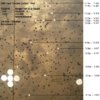Tim Singleton
Gold $$ Contributor
I don't know of any BR competitors that would agree seating is coarseFull seating testing(Berger recommended) shows totally opposite of this.
Seating is coarse, powder is fine.
I don't know of any BR competitors that would agree seating is coarseFull seating testing(Berger recommended) shows totally opposite of this.
Seating is coarse, powder is fine.
I can't disagree..... I'm only sharing MY way.Full seating testing(Berger recommended) shows totally opposite of this.
Seating is coarse, powder is fine.
I can't disagree..... I'm only sharing MY way.
#1...jam-seat some bullets, average and set the seating die, LOCK it
#2...start somewhere safe and work up incrementally to failure, ie find MAX
#3...if see anything promising, play with charge. If not, shoot a sequence trying to find "node" or"nodes"
#4...once a possible node is established, tune from the center of this node using seating depth.
#5...(never works consistently for me but, PUNT) try different neck tensions
#6...(never works consistently for me but, PUNT) try different primers
#7...(never works consistently for me but, PUNT) try the tuna
#8...(never works consistently for me but, PUNT) try another powder
Sometimes nowadays I'll skip all this fooferaww and just try another bullet if I've built the platform for more than one option.
And, mainly, when a gun just SHOOTS HOLES from the get-go, when all's ya got's ta' do is change the SHAPE of the holes.... ya' got a winner.
And if it DON'T???
Most offen YA DON'T....
Just 3 shots
Those Barts bt's are pretty amazing
That barrel went away and I went back to the middle of the pack.Hey Tim...if you are still shooting that combo where did you actually end up for powder and seating?
What I was trying to show with this pic. Until the seating depth is right they just won't shoot. Put any powder charge in it you like it won't be to it's full potential until the seating depth is right.i know you can do it Al
Lot10what lot of lt was that?
did you ever chrono it?


Faster, but shorter probably had something to do with it too! So cool, here we are talking sine waves, and earlier I was reading somebody’s post with F=ma! If I knew you guys liked to talk dirty like this I would have been on here years ago.oops, ledd beat me..... faster typer
Yes it has.I appreciate that my own testing could jive me the answers Im looking for but like everything in life I have to balance my testing with time, cost etc so Ive never managed to do this yet, thats why I ask the collective from time to time if they have done what I propose?
Something that sill leaves me wondering right now is this;
I usually start by tuning my powder charge at a nominal seating depth, generally this would be 20 thou off unless I have historical data that showed me a particular bullet liked a certain jump/jam, all testing is then done and the powder charge is established. I usually use and OCW style test at 100, 200 or 300 yards to establish powder charges, depending on conditions. On small cases this will be 0.2gr increments or 0.1gr to fine tune.
Next I go on to seating depth tuning, I tend to load a batch of ammo long, say 50 thou past jam length and I then seat the bullets at the range at various lengths as I need them. If my OCW testing has shown the seating depth might be close, say groups in the 0.5" or smaller I will often start by moving 5 thou forwards or backwards to see what effect, sometimes adjustments will be more or less corse than 5 thou depending on groups sizes, I rarely see 2 thou making any difference. Often I will only fire two shots because if the trend is showing the groups are opening I will go the other way. Generally 30-40 shots is enough to get the groups tightened up and there will be enough ammo left for one or two 5 shot groups to verify.
I do wonder though if the original powder charge that looked so sweet at say 20 thou off has been affected if my final seating depth tuning that say now has me at 5 thou jam or any other length different to 20 thou off?
I guess what Im trying to find out is if the seating depth adjustments are affecting the harmonic vibration tune or if they are just timing the bullet exit into sync with the harmonics? Or in other words does one affect the other or are they working independently to achieve an optimum?
I suppose I could always go back to a fine adjustment powder charge test once the optimum seating depth has been found and that would tell me?
Yes it has.

